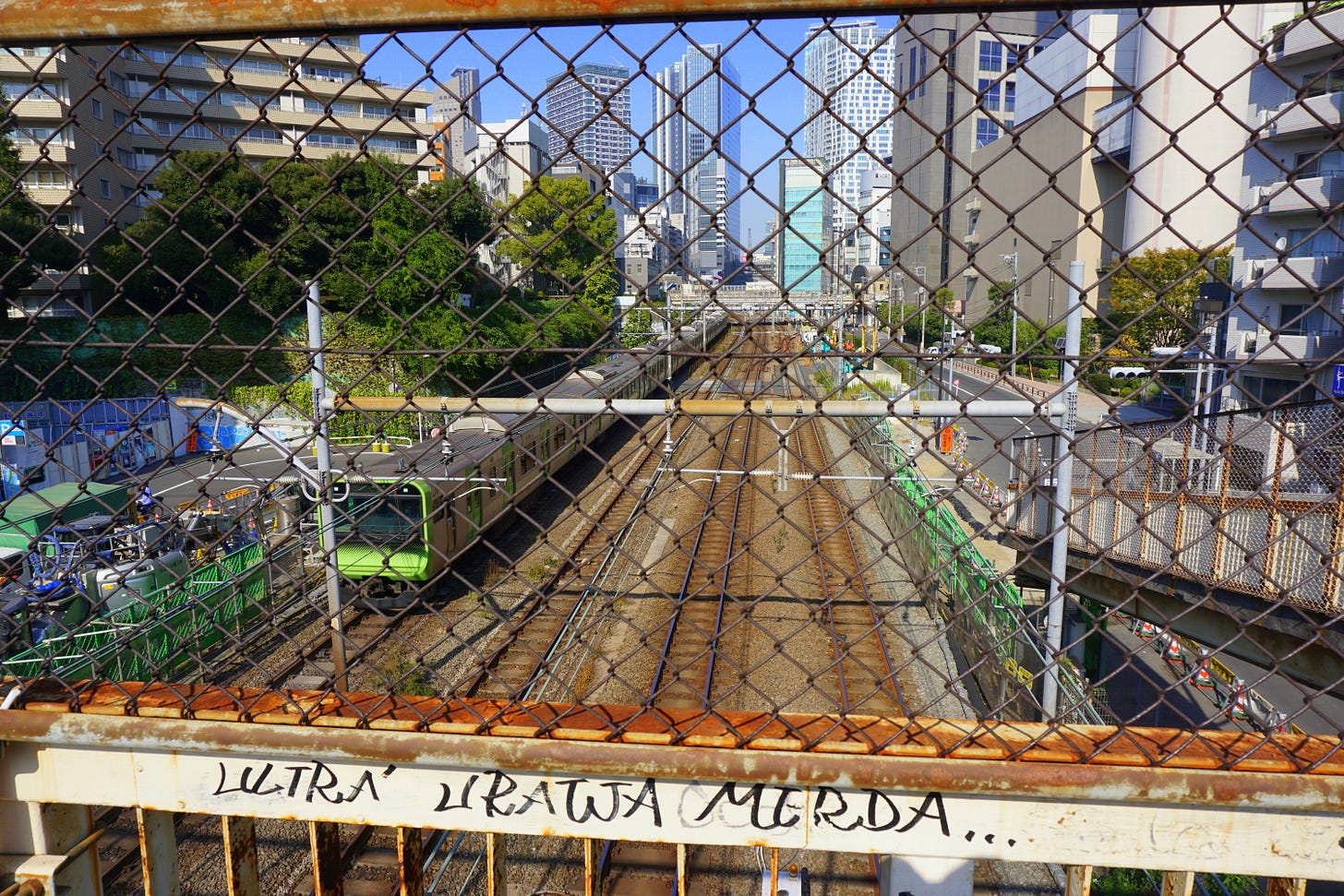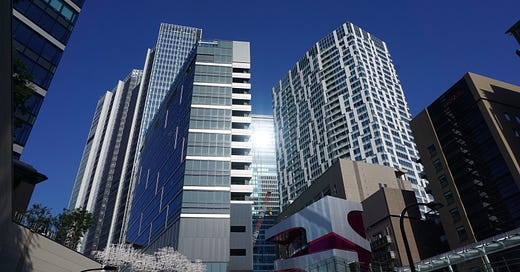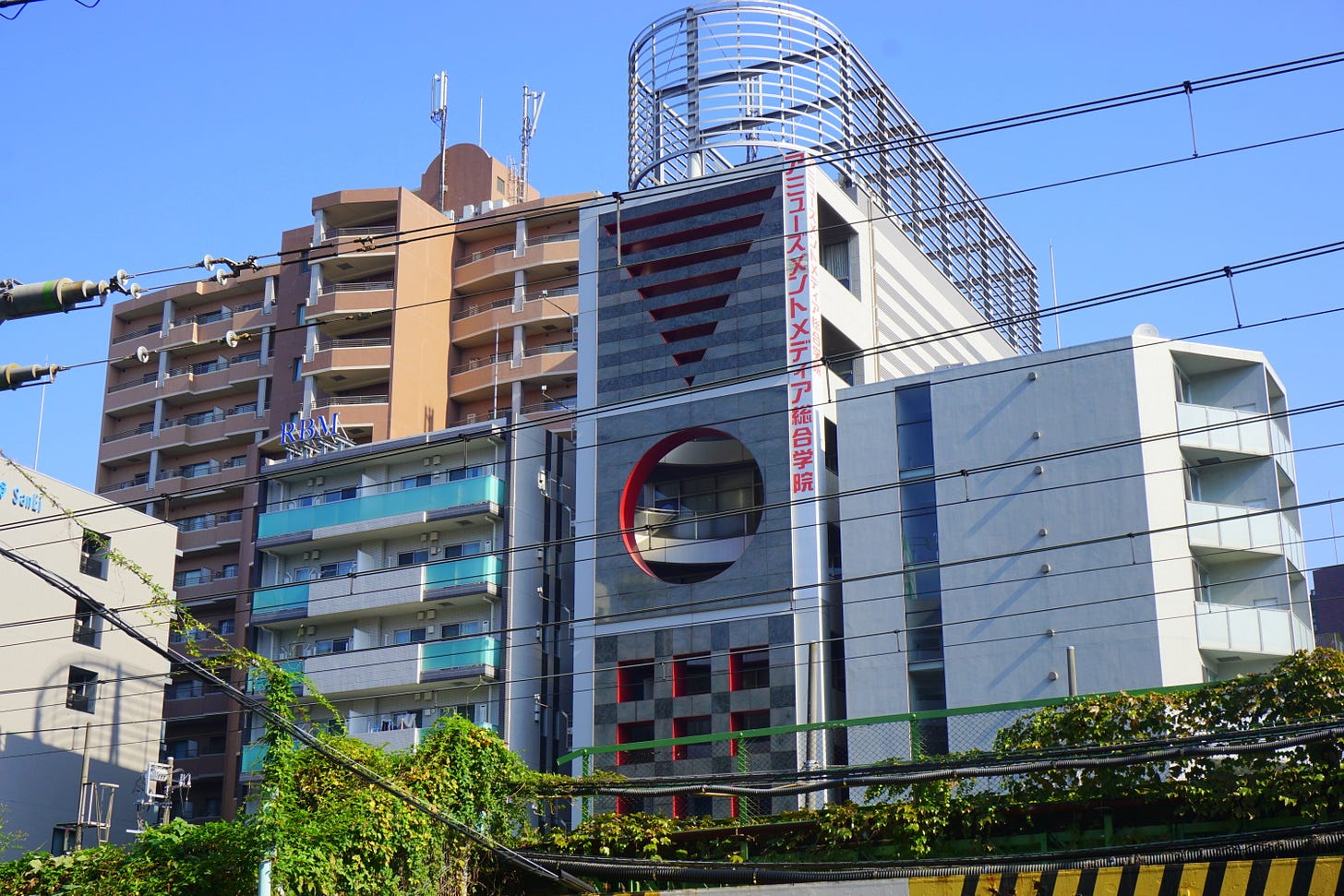Sakura Stage (see my previous post) is another step toward turning Shibuya into a modern, impersonal, bland district barely distinguishable from similar areas in central Tokyo. In the past, at least they knew how to combine modernity with originality, like the alien building near my old school.
Clueless walkers turn a corner in a perfectly normal, nondescript neighborhood and find themselves confronted by a bizarre apparition that nearly defies description. Sleek aluminum panels, intricately jointed, fit together like armor plating, forming gills and a segmented carapace. Chrome-polished pistons – almost limb-like – glint beneath angular visors. Above it all, a gleaming metallic egg is cradled between two spiny red antennae curving dramatically into the sky.
This “creature” – the Aoyama Technical College, designed by Watanabe Makoto – evokes the aesthetics of Gundam-style mecha. It’s like a hallucination – hard to decipher, yet instantly captivating. Put it in a museum, and it might invite cultural interpretation. Out here, all we can do is acknowledge its presence and the sense of dislocation it creates.
Getting away from the high-rises and following the southbound Yamanote tracks, I find myself in a completely different world made of old dilapidated buildings decorated with graffiti and stickers.
It also seems to be the favorite route of the few joggers who dare run around this part of the city squeezed between the ubiquitous construction sites, rusting railways overpasses, and the trains rattling on the other side of the fence. They rush by every minute, sometimes even every 15 or 20 seconds. I know it for sure because I timed them.

I overtake a young lady pushing a sort of stroller. I was about to call her a young mother, then I notice that the stroller is occupied by two small dogs she is taking out for a "walk."
Dogs and other pets are the new children. As of recent estimates, there are approximately 16 million cats and dogs in Japan, compared to about 14 million children under the age of 15. Many pet owners refer to themselves as “papa” or “mama,” and pets have Instagram accounts, birthday parties, and wardrobes.
And why not?
Think about it. Many people live in small apartments where raising children can be logistically and financially difficult. If you are going to raise a creature in a rabbit hutch, you are probably better off with an actual rabbit. Have I mentioned that kids are expensive? Just think about the cost of education.
Then, if you are a woman, you will probably have to kiss goodbye to your career, sooner or later, and become a cook, waitress and all-around servant to a stranger who, in 15 years or so, is going to hate your guts. Pets, on the other hand, offer unconditional love and companionship. They provide structure to daily life, similar to the emotional experience of raising a child, but without all the screaming and shouting.
Just think of the difference: pets are cute forever. Not like kids who turn into ugly pimply ungrateful monsters by the time they hit puberty.
That’s, at least, what my 30-something friends say.
In Tokyo, nothing is ever thrown away.
Like those butchers who pride themselves in using all the parts of the animal they have just killed, the Tokyo flaneur with a keen eye and a sincere interest in this city can find something appealing or interesting anywhere.
Take, for instance, the buildings lining up across the railway. They are not particularly appealing, that's true, but even these few unassuming buildings show you how things work in Tokyo as far as city planning and architectural rules work.
In other words, there are none.
There are buildings of every size and shape and style rising next to each other, with only the barest of space separating them. Probably they cannot exceed a certain height, but that's more or less the only rule they can't break. Basically, you can choose the color and design you want without any interference whatsoever from the authorities. Maybe some of the neighbors may complain, but most of the time they can do nothing about it. You can even design the most outrageous structure and get away with it, like when, in 2007, Umezu Kazuo, the “god of horror manga,” painted his house in vivid red and white horizontal stripes – a design mirroring his signature attire.
His neighbors were not overly sympathetic. They felt it clashed with the area's traditional ambiance and described it as "violence of colors." They even sought legal arbitration to address their concerns, but to no avail.
Tokyo's architecture is, to put it mildly, wildly eclectic. Its apparent lack of a unified style gives the city an uncanny, almost otherworldly character, like the retro-futuristic landscapes imagined in science-fiction films such as Blade Runner: a vision of the future that feels both post-historical and post-stylistic, inhabited by chaotic, hybrid forms.
Tokyo’s cityscape seems to exist outside of time, both archaic and futuristic in equal measure. This layered mix of architectural eras and impulses evokes, for me, a dystopian future teeming with survivors of some catastrophe.
Dear readers, thank you very much to all the people who have recently opted for a paid subscription.
If you like what I do and would like to support Tokyo Calling, don’t forget the special 80% discount on annual paid subscriptions.
$30 → $6 (see link above)
Here’s a chance to support Tokyo Calling for cheap!









In Japan I often pity those dogs unnecessarily clad in some “cool “ outfits contradicting their nature. Japan, let’s make kids before you disappear or taken over by big neighbours (:
Interesting article, Gianni. Yeah, pets are the new kids in Sydney, too. Especially dogs. You can't walk along footpath in Sydney without making way for the almighty dog and owner.